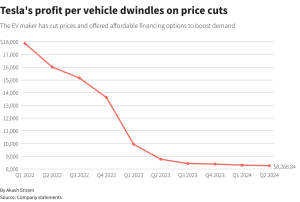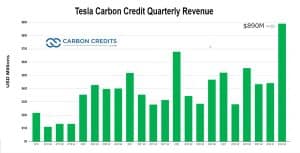Tesla reported its lowest profit margin in over five years and missed Wall Street earnings targets in Q2, as the company cut prices to boost demand while increasing spending on AI projects. However, Tesla’s carbon credit (regulatory credits) revenue is at an all-time high, hitting $890 million.
Tesla Profit Struggles Amid Carbon Credit Sales Surge
Tesla reported a 45% drop in profit for Q2, earning $1.5 billion on $25.5 billion in revenue, compared to $2.7 billion on $24.9 billion in the same period last year. Thus, the operating profit margin fell to 6.3% from 9.6%.
This decline in profit increases pressure on CEO Elon Musk to find new growth avenues. Despite this, Tesla shares have surged 40% since May, driven by investor optimism that Musk will transform Tesla into an AI company offering driverless taxis and robots.
Tesla’s Q2 electric car sales fell 4.8% to 444,000 vehicles, with production down 14% to about 411,000 cars. This setback follows a 55% drop in profit and a 9% revenue decline in Q1 2024.
Tesla faces increasing competition as other manufacturers ramp up electric vehicle production. For the first time, Tesla’s share of U.S. electric vehicle sales fell below 50% in Q2, according to Cox Automotive.
Amid all these lackluster results, the EV giant has seen a record-high sale of carbon credits at $890 million, the highest since the company started selling these regulatory credits in 2017. This revenue stream is up 216% from $282 million a year earlier and a 102% increase from Q1 ($442m).
Competition Hits Tesla Hard: Carbon Credits to the Rescue
Most notably, the $890 million carbon credit revenue is almost 60% of Tesla’s Q2 net income of $1,494 million. Thus, carbon credit sales bolstered the company’s bottom line.
This additional revenue stream is essentially pure profit, as companies can bank credits exceeding their immediate needs. For an EV-only company like Tesla, which has no combustion business to offset, the constant flow of these credits has been a financial “gusher,” comparable to a highly profitable oil strike in the fossil fuel industry.
Tesla continues to profit from selling carbon credits to competitors who need to comply with emissions standards. This business model is highly lucrative for Tesla, as earning these credits incurs minimal costs, translating to pure profit. This revenue stream has been crucial for Tesla’s financial success.
The EV maker aims to produce new, more affordable EVs by early 2025, though cost reductions will be less than expected. The company laid off over 10% of its workforce to reduce costs, and profits were impacted by restructuring charges and higher operating expenses driven by AI projects. Automotive gross margin, excluding regulatory credits, was 14.6%, below the estimated 16.29%.
As a result of a series of price cuts, profit per vehicle plummeted.

Elon Musk acknowledged that the influx of more affordable electric cars from other manufacturers “has made it more difficult for Tesla” to sell vehicles. From April through June, Tesla’s share of U.S. electric vehicle sales dropped to 49.7%, down from 59.3% a year earlier, according to Cox Automotive.
Ford Motor sold nearly 24,000 EVs in Q2, a 61% increase from a year ago, while General Motors’ sales of battery-powered models rose 40% to nearly 22,000 vehicles. Investment analyst Dan Coatsworth noted that Tesla has missed earnings targets for four consecutive quarters.
Another Growing Business For Tesla
CEO Elon Musk highlighted that new competitors have significantly discounted their EVs, challenging Tesla. The company’s EV deliveries have declined for two quarters, facing rising competition and slow demand due to a lack of affordable new models. Sales of China-made EVs, which are also exported, fell in Q2 compared to strong growth from Chinese automakers like BYD Co.
Despite these challenges, Tesla expects a production increase in Q3. Amid declining profits, the company has seen significant growth in its rapidly growing energy storage business.
In Q1 2024, energy storage deployments reached a record 4.1 GWh, with revenue and gross profit from the Energy Generation and Storage segment hitting all-time highs.
In Q2 2024, Tesla Energy deployed 9.4 GWh of energy storage products, including Megapacks, Powerwalls, and solar products. This marks a 132% increase from Q1 2024 and a 157% year-over-year rise.
The growing number of Megapack installations and an expanding fleet are expected to drive consistent profit growth in this segment. Battery system sales, primarily for electricity grids, doubled to $3 billion in Q2.
Tesla’s Q2 financials reflect a significant drop in profit and production amid intensified competition and rising operating costs. However, record-high carbon credit sales provided a crucial boost to the bottom line, demonstrating the importance of this revenue stream. As Tesla navigates these challenges, its investments in AI and energy storage hint at new growth avenues beyond electric vehicles.



